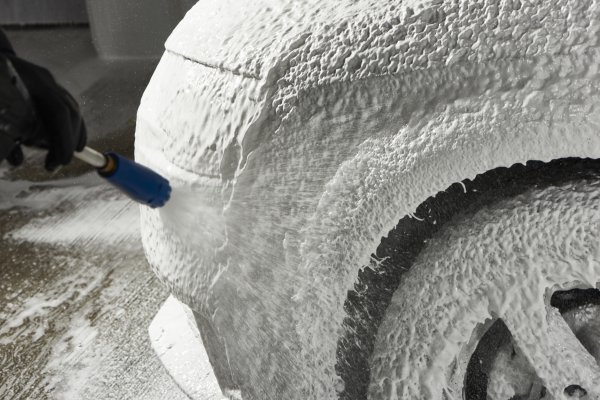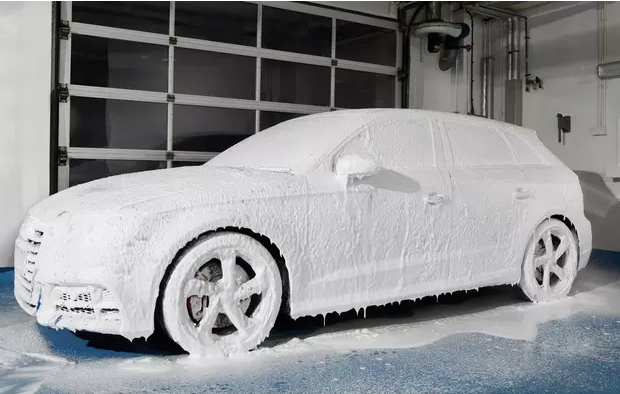Richard Tipper has been valeting cars of all shapes and sizes since 1989, and can spend up to a week detailing every inch of a car. He has gone through more cleaning accessories and products than you’ll find on the shelves of an automotive superstore. These are Tipper’s Tips for the Hagerty community.
Let it snow, goes the joke among detailers when they unleash a snow-like foam all over a filthy car. You may have a faint idea of what I’m talking about, since detailers’ and car enthusiasts’ social media platforms are full of artistic photos and video clips of cars covered in a thick foam that makes it look like they were dunked in one of those baths where the children added an entire bottle of bubble bath when you weren’t looking.
And rarely a day goes by where I’m not asked about snow foam; Are they worth it? Do they work? What do they do? How are they applied? What equipment do I need?

Let’s talk about what it does and where it fits into a methodical ‘safe’ car cleaning routine. Detailing refers to the exceptionally thorough transformation of a car following a cleaning and polishing process. In the ‘States, the term ‘detailing’ has described car cleaning for as long as I can remember. Some will recall “Biff’s Detailing” on the side of his pick-up truck in 1985’s Back to the Future! That label has been adopted to distinguish the differences from having a car washed and waxed – valeted, in traditional speak. (The differences between detailing and valeting will be covered in a future column.)
Since it’s been discovered that fine scratches and swirls are largely inflicted during the washing process, methods and products have been established to help prevent this from happening. Years ago, potentially harmful caustic-based cleaning chemicals were applied to the lower sections of a car’s bodywork, before any washing would take place, to remove dirt from the grubbiest parts of the car. When not diluted correctly, they can tarnish the aluminium running boards on your BMW X5 or Mercedes ML, for example.
Less harmful alternatives were brought to market for the discerning enthusiast and professionals to use as an effective alternative. More recently snow foam has become the gold standard within the delicate cleaning process. Their purpose is to loosen the harmful grit from within the dirt. This is achieved by the cleaning agents in the foam clinging to the grit and safely lifting it from the surface of the paint.

The foams are aerated using the Venturi principle, a job that’s performed by a foam gun attachment that fits to pressure washers or garden hoses. The foam should be applied to a dry car for maximum effect, cover the whole car and needs several minutes to dwell on the surface. In that time it will be loosening the surface grit which comes off when you rinse the foam away.
Rinsing should be from the bottom of the car first, in continuous horizontal passes. “What?!” you’re thinking. “Don’t you rinse from the top down?” The reason for doing it this way is that as you work you’ll be able to see that jet of the pressure washer or hose has run over all parts of the side of the car. If you start from the roof, water will run all over the place, making it harder to tell what you have and haven’t passed over.
With the foam removed, in most cases the car will still be dirty. Fear not! This is normal as the foam does not replace the need to physically wash the car. It simply removes the grit to reduce the risk of it being rubbed over lovely glossy paint and scratching the surface.
Most manufacturers of pressure washers now offer a snow foam lance attachment as standard or as an accessory, with prices starting from £20 and ranging to more than £60. Alternatively, aftermarket attachments can be bought from a valet products supplier. Attachments are also available for a garden hose but these can be reliant on good water pressure, not always the case with some outdoor taps. The foam itself costs from about £10 for a couple of litres, considerably more for some brands.
Snow foam works when applied properly and from a recommended source. It can’t and isn’t meant to replace the hand washing process. It simply helps remove damaging grit from the paint surface. And surprise, surprise, it is most effective when used on paint which is regularly cleaned, polished, and protected.










And what’s the enviromental effect of washing off foam (and detergents) into the drainage systems?
Probably the same as you washing your hair everyday in the shower.
Most good Snow Foam are ph neutral so as not to attack the wax which is on many cars, so are safe to discharge as mains effluent
There are a lot of enviromentaly friendly snow foams out there.